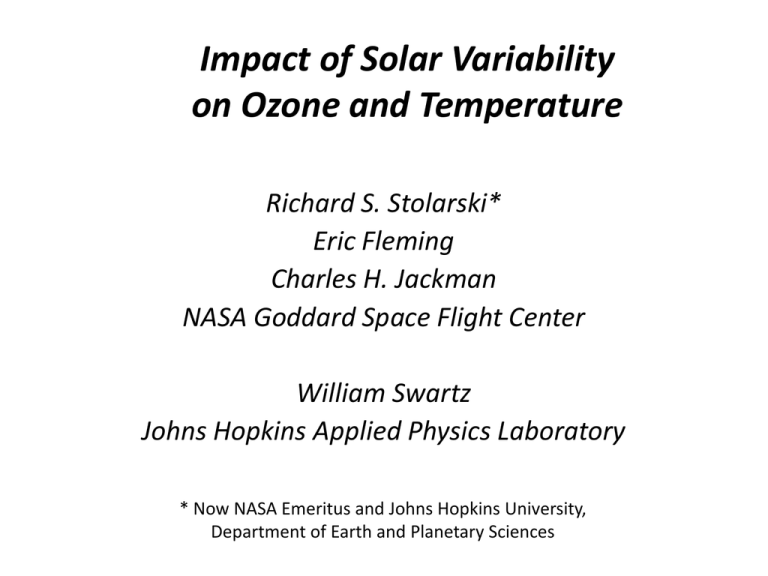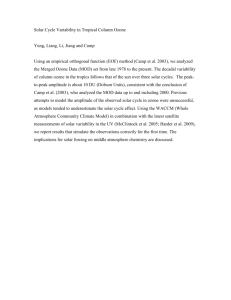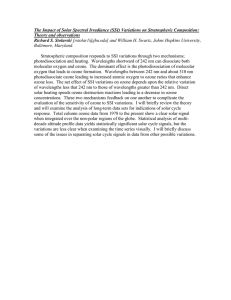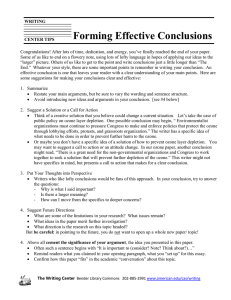Impact of Solar Variability on Ozone and Temperature
advertisement

Impact of Solar Variability on Ozone and Temperature Richard S. Stolarski* Eric Fleming Charles H. Jackman NASA Goddard Space Flight Center William Swartz Johns Hopkins Applied Physics Laboratory * Now NASA Emeritus and Johns Hopkins University, Department of Earth and Planetary Sciences How do stratospheric ozone and temperature respond to the solar cycle? • Direct heating – hν + O2, O3 T increase – speeds ozone loss reactions O3 decrease • Photolysis – hν + O2 produces O3 O3 increase – More O3, more heating T increase Same direction for temperature Opposite direction for ozone Chemistry Transport Model Sun Radiation (Temperature) Dynamics (Meteorology) Chemistry (Constituents) Surface Sources Chemical Reaction Coefficients Atmospheric General Circulation Model Sun Radiation (Temperature) Dynamics (Meteorology) Surface Energy Balance Chemistry (Constituents) What is a chemistry/climate model? A chemistry climate model is a general circulation model of the atmosphere in which the concentrations of radiatively-active gases are self-consistently calculated and used to determine atmospheric heating and cooling rates. Sun O3, CO2, H2O, CH4, N2O, CFCs Chemistry Climate Model Dynamics (Meteorology) Surface Energy Balance Radiation (Temperature) Chemistry (Constituents) Surface Sources Chemical Reaction Coefficients Evaluation of Chemistry Climate Models – SPARC initiative called CCMVal Published papers in JGR, Eyring et al. (2006, 2007), Waugh and Eyring (2008) Range of all models (18) Models are tested in CCMVal for their quality in reproducing observed processes, e.g. isolation of polar vortex, speed of residual circulation, tropical/mid-latitude mixing. The selection of “best” models can then be tested for how well they reproduce long-term trends of last 3 decades. Range of models that were judged to have best process representation (3,6) Estimates of Solar Impact on Ozone and Temperature in the Stratosphere using GEOS CCM Used Lean estimates of spectral variation from solar max to min Latitude dependence of solar effect on total column ozone Note strong interannual variability in Max – Min in high latitudes 2 SEM Global Average Response to Solar Variation Ozone response to heating is much smaller than response to photolysis and in opposite direction. Temperature response to photolysis is comparable to and is in same direction as response to heating. Stratospheric temperature response to 11-yr solar cycle forcing GISS Model E SMax-SMin TSI* 1.2 W/m2 Cahalan et al. [in press 2010] Lean SSI Harder SSI GEOS CCM-StratChem Lean SSI SMax-SMin TSI* Scaled to 1.2 W/m2 Stolarski & Swartz [this work] *TSI for 200-10,000 nm Heating Only Heating+Photolysis Solar Cycle in Quasi-Global (60S-60N) Total Ozone Blue is model sensitivity calculated from max/min simulations scaled to F10.7 Red is F10.7 term derived from time-series analysis of merged ozone data. Construction of Merged Ozone Data Sets TOMS/SBUV Merged Ozone Data (MOD) http://acdb-ext.gsfc.nasa.gov/Data_services/merged/ Ozone Profiles from Backscatter Ultraviolet Data Upper stratospheric data from 4 satellites SBUV instruments provide longest data set with near-global coverage Major issue is establishing relative calibration when there is no overlap of instruments in good parts of drifting orbits; as in 1997 with NOAA 9 and NOAA 11. Total column ozone data set from TOMS and SBUV backscatter UV instruments Removing Natural Variability from the Ozone Record • Chlorine impact should have leveled off in last decade • First solar cycle in 30-year record without major volcanic eruption • Should also be a slow climatechange impact on stratospheric ozone that is difficult to separate from other variations How much ozone will there be in the postCFC era? We use our chemistry climate models (CCMs) to try to answer this question. Upper stratospheric ozone increases because of GHG cooling Tropical ozone won’t change at all X14 decades=~30 more DU in 2100 compared to 1960 Lower stratospheric ozone decreases in tropics and increases at high latitudes: signature of circulation change Deducing 11-year solar cycle effects from time-series analysis: the importance of time lags Computation of time delay from Goddard 2D CTM for solar cycle effect (Fleming and Jackman). Model was run with and without solar cycle in timedependent mode. Time-series regression analysis for solar cycle from model simulation with all perturbations Ignoring time delays can modify magnitude of signal and introduce false signals -- even without interannual variability of real atmosphere (or CCM) Summary and Conclusions • Ozone is no longer decreasing in the stratosphere • Attribution of this leveling off to decrease of chlorine containing compounds is complicated by several factors – Underlying changes in climate/temperature – Phase and importance of solar cycle – Natural, decadal scale variability • Solar cycle impact on ozone and temperature depend on both direct heating and photolysis – Additive and approximately equal for temperature – Opposite direction for ozone dominated by photolysis
![Richard S. Stolarski [], Eric Fleming, and Charles H.](http://s2.studylib.net/store/data/013086448_1-495cd425bcabb06346bcc7eab6519905-300x300.png)





![Attribution of the 11-Year Solar Cycle in Lower-Stratospheric Temperature and... Ales Kuchar [], Eugene Rozanov , William Ball](http://s2.studylib.net/store/data/012725756_1-0e253eb2ba08316b8369ea70f516fffb-300x300.png)